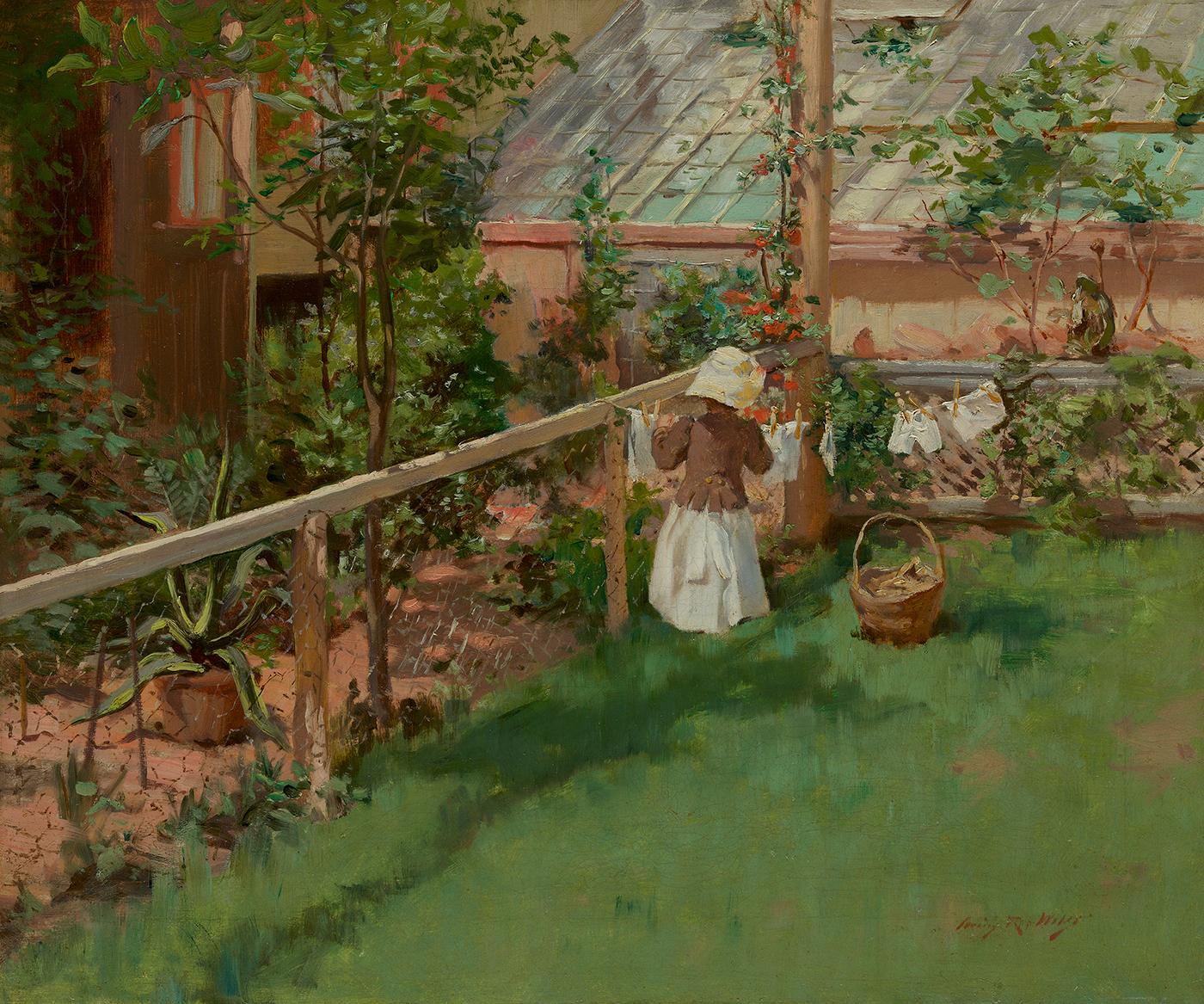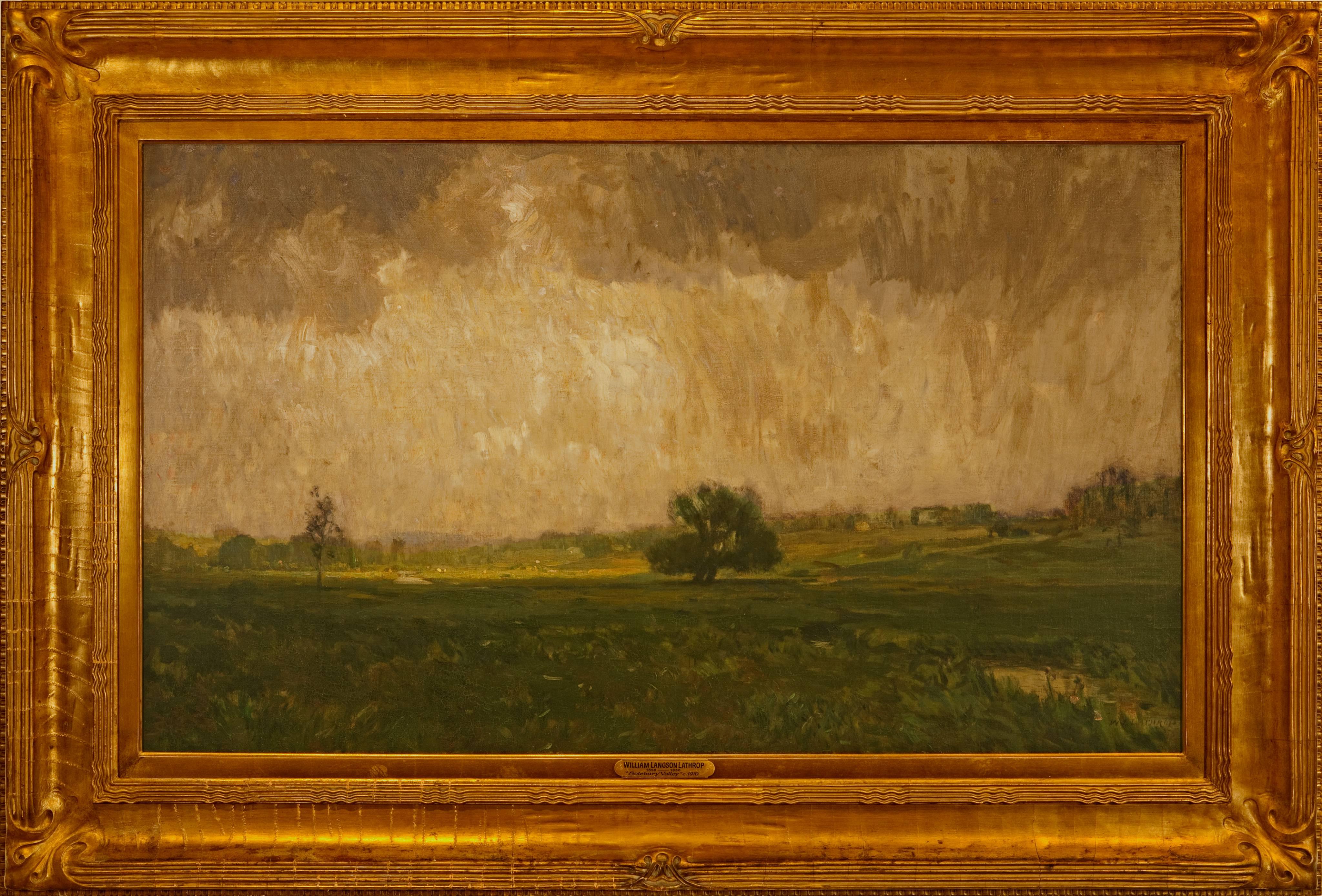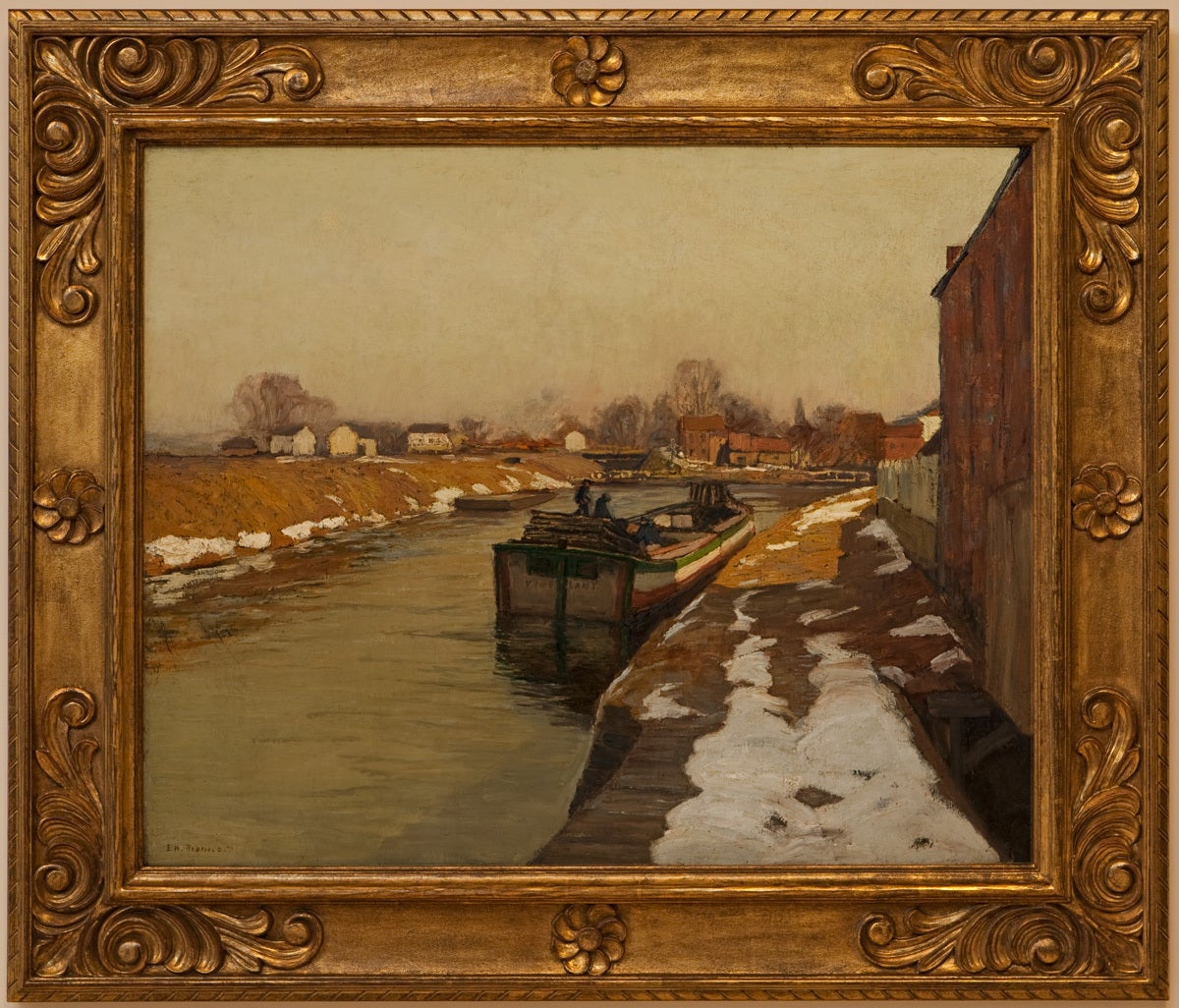Charles Henry MillerStyle of Troyon Impressionist Painting by C.H. Millerc. 1885
c. 1885
About the Item
- Creator:Charles Henry Miller (1842-1922, American)
- Creation Year:c. 1885
- Dimensions:Height: 14 in (35.56 cm)Width: 17 in (43.18 cm)Depth: 3.5 in (8.89 cm)
- More Editions & Sizes:Unique Price: $4,250
- Medium:
- Movement & Style:
- Period:
- Condition:Minimal areas of loss to paint and frame.
- Gallery Location:Larchmont, NY
- Reference Number:1stDibs: LU2211212087922
Charles Henry Miller
Charles Henry Miller was a noted artist and painter of landscapes from Long Island, New York. The American poet Bayard Taylor called him, "The artistic discoverer of the little continent of Long Island." Miller was educated at Mount Washington Collegiate Institute and graduated in medicine at the New York Homeopathic Institute in 1864. Before his graduation, Miller had occasionally painted pictures and in 1860, he exhibited The Challenge Accepted at the National Academy of Design, in New York City. Miller lived in Queens at the summer estate, Queenslawn, originally purchased by his parents. Miller went abroad in 1864 and again in 1867 and was a pupil in the Bavarian Royal Academy in Munich under the instruction of Adolf Lier. After the 1874 death of his father, Jacob Miller, who was a wealthy architect and builder, Miller received a large inheritance that allowed him to paint as an independent artist for the remainder of his long life. Miller worked seriously and exhibited regularly, including at international exhibitions. The majority of his oil paintings depict Long Island subjects, especially those in and around Queens Village. Fed up with the development of the eastern part of Queens (present-day Nassau County), Miller began to spend part of his summers in East Marion, Long Island, c. 1910. Here Miller spent his time sketching and painting the surrounding areas. In 1885, Miller published The Philosophy of Art in America, using the pseudonym Carl De Muldor (he was descended from the De Muldor family). His work was recognized: in 1873, Miller was elected an associate of the National Academy of Design and an academician in 1875. Miller served as president of the New York Art Club in 1879 and of the American Committee at the Munich International Exposition in 1883.
- ShippingRetrieving quote...Ships From: Larchmont, NY
- Return PolicyA return for this item may be initiated within 14 days of delivery.
- George Gách painting of Glenwood Landing, Long Island, signedBy George GachLocated in Larchmont, NYGeorge Gách (American, 1909-1996) The Old Tree in Glenwood Landing, 1957 Oil on canvas 23 x 27 in. Framed: 26 x 29 1/2 in. Singed lower right: Gách 1957 Provenance: Garden City Galleries, Garden City, NY Includes brochure. Born in Hungary, George Gách, the son of sculptor Stephen Gách (1880-1962), was noted for sculpture, impressionist painting and teaching. His subjects included animals, people, florals, nudes, cowboys, sports and scenes of Long Island, Bermuda, Mexico, Florida and upstate New York. Among his sculpture subjects are portrait busts of prime ministers, governors, corporate presidents and soccer stars. He served as a commercial pilot from 1939 to 1952. and in 1944, was shot down and given up as dead. He was also in prisoner of war camps twice during World War II and then in 1947, was almost imprisoned by the communists in Hungary. Gách graduated form the Academy of Fine Arts in Budapest in 1939, and then immigrated to the United States. He located his studio in Roslyn Heights Long Island, and at one point set a goal...Category
1950s American Impressionist Landscape Paintings
MaterialsCanvas, Oil
- Charles Henry Miller Impressionist Landscape Oil PaintingBy Charles Henry MillerLocated in Larchmont, NYCharles Henry Miller (American, 1842-1922) Untitled (New York Landscape), c. 1900 Oil on canvas laid on foam 6 1/8 x 10 5/8 in. Signed lower left: C.H.M. Charles Henry Miller was a noted artist and painter of landscapes from Long Island, New York. The American poet Bayard Taylor called him, "The artistic discoverer of the little continent of Long Island." Miller was educated at Mount Washington Collegiate Institute, and graduated in medicine at the New York Homeopathic Institute in 1864. Before his graduation, he had occasionally painted pictures, and in 1860 he exhibited The Challenge Accepted at the National Academy of Design, in New York City. He lived in Queens at the summer estate, Queenslawn, originally purchased by his parents. He went abroad in 1864 and again in 1867, and was a pupil in the Bavarian Royal Academy at Munich under the instruction of Adolf Lier. After the 1874 death of his father, Jacob Miller, who was a wealthy architect and builder, Miller received a large inheritance that allowed him to paint as an independent artist for the remainder of his long life. He worked seriously and exhibited regularly, including at international exhibitions. The majority of his oil paintings depict Long Island subjects, especially those in and around Queens Village. Fed up with the development of the eastern part of Queens (present-day Nassau County), he began to spend part of his summers in East Marion, Long Island, c. 1910. Here he spent his time sketching and painting the surrounding areas. In 1885 he published The Philosophy of Art in America, using the pseudonym Carl De Muldor (he was descended from the De Muldor family). His work was recognized: in 1873, he was elected an associate of the National Academy of Design and an academician in 1875. He served as president of the New York Art Club in 1879 and of the American Committee at the Munich International Exposition in 1883. Legacy and honors • In 1910 Miller founded the Queens Borough Allied Arts & Crafts Society. • A New York City public school, Queens P.S. 33, was once named for him. • 1878, gold medal awarded by the Massachusetts Charitable Association • 1885, gold medal at the World's Exposition in New Orleans. Following is a list, which includes many of his known exhibitions: • National Academy of Design, New York, NY, 1860-61, 1865-67, 1870-1921 • Brooklyn Art Association, Brooklyn, NY, 1872-84, 1891-92 • Artist's Fund Society, New York, NY, 1874 (exhibition & sale), 1886 (exhibition & sale) • Century Association, New York, NY, (1874-1917) • Philadelphia Centennial Exhibition, Philadelphia, PA, 1876 (prize) • Society of American Artists, New York, NY, (1878-1882) • Massachusetts Charitable Mechanic Association, Boston, MA, 1878 (prize) • Paris International Exposition, Paris, France, 1878, 1889 • American Water Color Society Exhibition, New York, NY, 1879 • Pennsylvania Academy of Fine Arts, Philadelphia , PA, 1879-99 • Boston Art Club, Boston, MA, 1880-1907 (prize) • Union League Club, New York, NY, 1880 • Lotos Club, New York, NY, 1880, 1896, 1899-1900, 1906 • Salons of Paris, Paris, France, 1882 • International Exhibition, Munich, Germany, 1883 (president & exhibitor) • New Orleans Exposition, New Orleans, LA, 1885 (prize) • Art Institute of Chicago, Chicago, IL, 1888-89, 1891, 1894-98, 1904 • Fifth Avenue Art Gallery, New York, NY, 1889 (exhibition & sale) • World's Columbian Exposition, Chicago, IL, 1892 • Frederick A. Chapman Gallery, New York, NY, 1898 (solo) • Miller Studio...Category
Early 20th Century American Impressionist Landscape Paintings
MaterialsFoam, Oil, Canvas
- Original James M. HartLocated in Larchmont, NYJames MacDougal Hart (American, 1828-1901) Untitled (After Troyon), 19th century Oil on canvas 18 1/16 x 30 1/16 in. Framed: 31 1/2 x 40 1/2 in. Signed lower right: James M Hart...Category
19th Century American Impressionist Landscape Paintings
MaterialsCanvas, Oil
- Impressionist Painting of French coast, St. Tropez, by Frederick FrederLocated in Larchmont, NYFrederick Freder (American, 1895-1954) St. Tropez, France, 1921 Oil on canvas 26 x 32 in. Framed: 32 x 38 in. Signed verso: Frederick C. Freder, The Palm Tree, Saint Tropez, St. Trop...Category
1920s American Impressionist Landscape Paintings
MaterialsCanvas, Oil
- Impressionist Painting of Cows and Trees by C.H. Miller, Long IslandBy Charles Henry MillerLocated in Larchmont, NYCharles Henry Miller (American, 1842-1922) Untitled (Cows and Trees), c, 1885 Oil on canvas 18 x 24 in. Signed lower left: Chas. H. Miller, N.A. Charles Henry Miller was a noted artist and painter of landscapes from Long Island, New York. The American poet Bayard Taylor called him, "The artistic discoverer of the little continent of Long Island." Miller was educated at Mount Washington Collegiate Institute, and graduated in medicine at the New York Homeopathic Institute in 1864. Before his graduation, he had occasionally painted pictures, and in 1860 he exhibited The Challenge Accepted at the National Academy of Design, in New York City. He lived in Queens at the summer estate, Queenslawn, originally purchased by his parents. He went abroad in 1864 and again in 1867, and was a pupil in the Bavarian Royal Academy at Munich under the instruction of Adolf Lier...Category
1880s American Impressionist Landscape Paintings
MaterialsCanvas, Oil
- Farm At Dusk by Long Island Artist Charles H. Miller, 1865By Charles Henry MillerLocated in Larchmont, NYCharles Henry Miller (American, 1842-1922) Untitled (Farm at Dusk), 1886 Oil on canvas 16 x 27 in. Signed and dated lower right: Chas. H. Miller, N.A., 1886 Charles Henry Miller was a noted artist and painter of landscapes from Long Island, New York. The American poet Bayard Taylor called him, "The artistic discoverer of the little continent of Long Island." Miller was educated at Mount Washington Collegiate Institute, and graduated in medicine at the New York Homeopathic Institute in 1864. Before his graduation, he had occasionally painted pictures, and in 1860 he exhibited The Challenge Accepted at the National Academy of Design, in New York City. He lived in Queens at the summer estate, Queenslawn, originally purchased by his parents. He went abroad in 1864 and again in 1867, and was a pupil in the Bavarian Royal Academy at Munich under the instruction of Adolf Lier...Category
1880s American Impressionist Landscape Paintings
MaterialsCanvas, Oil
- At the ClotheslineBy Irving Ramsey WilesLocated in New York, NYSigned lower right: Irving R. WilesCategory
Late 19th Century American Impressionist Landscape Paintings
MaterialsCanvas, Oil
- "Alley Fiends"By John R. GrabachLocated in Lambertville, NJJim’s of Lambertville is proud to offer this artwork by: John R. Grabach (1886 - 1981) John Grabach was a highly regarded New Jersey artist, teacher, and author of the classic text...Category
1930s American Impressionist Landscape Paintings
MaterialsCanvas, Oil
- "Forest Strongholds"By John F. CarlsonLocated in Lambertville, NJSigned lower right. Complemented by a hand carved and gilt frame. Exhibited at the National Academy of Design, 1928Category
20th Century American Impressionist Landscape Paintings
MaterialsCanvas, Oil
- "Solebury Valley"By William Langson LathropLocated in Lambertville, NJSigned lower right. Complemented by a period frame. William L. Lathrop (1859-1938) Deemed “Father of the New Hope Art Colony”, William Langson Lathrop was born in Warren, Illinois. He was largely self-taught, having only studied briefly with William Merritt Chase in 1887, at the Art Students League. Lathrop first moved east in the early 1880s, and took a job at the Photoengraving Company in New York City. While there, he befriended a fellow employee, Henry B. Snell. The two men became lifelong friends and ultimately, both would be considered central figures among the New Hope Art Colony. Lathrop's early years as an artist were ones of continuing struggle. His efforts to break through in the New York art scene seemed futile, so he scraped enough money together to travel to Europe with Henry Snell in1888. There he met and married an English girl, Annie Burt. Upon returning to New York, he tried his hand at etching, making tools from old saw blades...Category
1910s American Impressionist Landscape Paintings
MaterialsCanvas, Oil
- Winter MoonlightBy George William SotterLocated in Lambertville, NJsigned lower rightCategory
1910s American Impressionist Landscape Paintings
MaterialsCanvas, Oil
- "The Canal"By Edward Willis RedfieldLocated in Lambertville, NJJim’s of Lambertville is proud to offer this artwork. Signed lower left. Complemented by a hand carved and gilt frame. Illustrated in "Edward Redfield: Just Values and Fine Seeing" by Constance Kimmerle and the Pennsylvania Academy of the Fine Arts's Exhibition of Paintings by Edward Redfield (April 17 to May 16, 1909) brochure Edward Willis Redfield (1869 - 1965) Edward W. Redfield was born in Bridgeville, Delaware, moving to Philadelphia as a young child. Determined to be an artist from an early age, he studied at the Spring Garden Institute and the Franklin Institute before entering the Pennsylvania Academy from 1887 to 1889, where he studied under Thomas Anshutz, James Kelly, and Thomas Hovenden. Along with his friend and fellow artist, Robert Henri, he traveled abroad in 1889 and studied at the Academie Julian in Paris under William Bouguereau and Tony Robert-Fleury. While in France, Redfield met Elise Deligant, the daughter of an innkeeper, and married in London in 1893. Upon his return to the United States, Redfield and his wife settled in Glenside, Pennsylvania. He remained there until 1898, at which time he moved his family to Center Bridge, a town several miles north of New Hope along the Delaware River. Redfield painted prolifically in the 1890s but it was not until the beginning of the twentieth century that he would develop the bold impressionist style that defined his career. As Redfield’s international reputation spread, many young artists gravitated to New Hope as he was a great inspiration and an iconic role model. Edward Redfield remained in Center Bridge throughout his long life, fathering his six children there. Around 1905 and 1906, Redfield’s style was coming into its own, employing thick vigorous brush strokes tightly woven and layered with a multitude of colors. These large plein-air canvases define the essence of Pennsylvania Impressionism. By 1907, Redfield had perfected his craft and, from this point forward, was creating some of his finest work. Redfield would once again return to France where he painted a small but important body of work between 1907 and 1908. While there, he received an Honorable Mention from the Paris Salon for one of these canvases. In 1910 he was awarded a Gold Medal at the prestigious Buenos Aires Exposition and at the Panama-Pacific Exposition of 1915 in San Francisco, an entire gallery was dedicated for twenty-one of his paintings. Since Redfield painted for Exhibition with the intent to win medals, his best effort often went into his larger paintings. Although he also painted many fine smaller pictures, virtually all of his works were of major award-winning canvas sizes of 38x50 or 50x56 inches. If one were to assign a period of Redfield’s work that was representative of his “best period”, it would have to be from 1907 to 1925. Although he was capable of creating masterpieces though the late 1940s, his style fully matured by 1907 and most work from then through the early twenties was of consistently high quality. In the later 1920s and through the 1930s and 1940s, he was like most other great artists, creating some paintings that were superb examples and others that were of more ordinary quality. Redfield earned an international reputation at a young age, known for accurately recording nature with his canvases and painting virtually all of his work outdoors; Redfield was one of a rare breed. He was regarded as the pioneer of impressionist winter landscape painting in America, having few if any equals. Redfield spent summers in Maine, first at Boothbay Harbor and beginning in the 1920s, on Monhegan Island. There he painted colorful marine and coastal scenes as well as the island’s landscape and fishing shacks. He remained active painting and making Windsor style furniture...Category
Early 1900s American Impressionist Landscape Paintings
MaterialsCanvas, Oil






